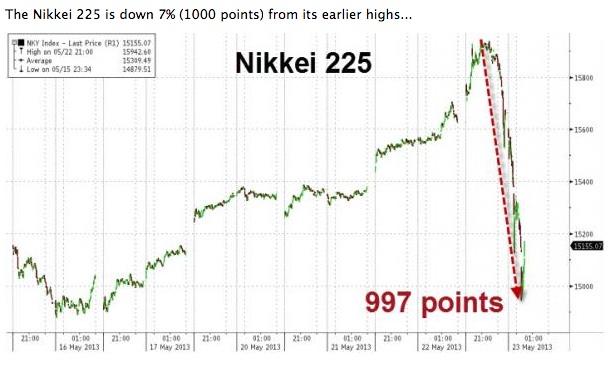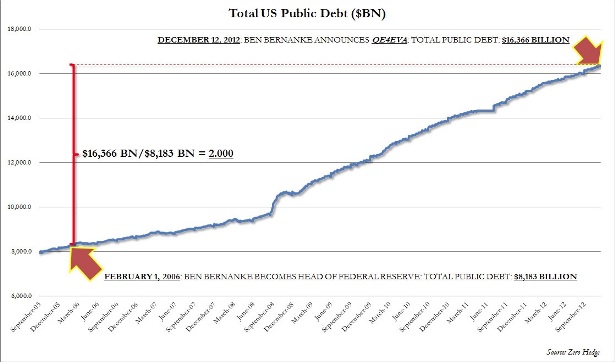The recent volatility of the Dow Jones Industrial Average indicates savvy investors on Wall Street are worried.
Should the Federal Reserve, under Chairman Ben Bernanke's replacement, "taper" the current Fed policy of buying U.S. Treasury debt, investors anticipate a sharp downward market correction, possibly even a market crash.
Last week, the Dow fell below 16,000 only to rally back over the barrier as Federal Reserve officials attempted to calm nervous investors.
This week, the U.S. Senate is expected to confirm Janet Yellen to replace Bernanke as Fed chief, despite the continuing attempt by Republicans to slow the confirmation of Obama administration appointees after Senate Majority Leader Harry Reid employed the "nuclear option," ending the requirement for a supermajority of 60 votes to force a vote.
Yellen, currently vice chairman of the Board of Governors of the Federal Reserve, is expected to begin ramping down Bernanke's policy known as "Quantitative Easing." Under the policy, the Federal Reserve has bought billions of dollars of U.S. Treasury debt to keep interest rates as close to zero as possible.
The concern is that stock prices have been inflated by excess liquidity pumped into the financial markets by the Fed purchase of U.S. debt. There are fears that the bubble will burst like the dot.com bubble in the late 1990s and the real-estate bubble in 2008 after the dramatic increases in housing prices.
In a market crash, typically only the first investors to get out of the market avoid losses, while others - typically retail investors and those in retirement savings markets, including 401(k) and IRA investments - lose market value as underlying investments drop quickly in value.
"Many market observers believe the central bank is unlikely to begin withdrawing stimulus, a process widely dubbed 'tapering,' this coming week," the
Wall Street Journal said Saturday. "But if the Fed does act, they say, the improving economy has left investors feeling more comfortable with the prospect of a pullback."
However, downward adjustments in the stock market in the past few months strongly suggest growth in the Dow is heavily dependent on the Fed continuing a policy of quantitative easing at the current levels.
'Flash crash'In May,
WND reported, all it took to trigger a global stock sell-off was a comment Bernanke made suggesting the Fed would consider backing off quantitative easing at one of its "next few meetings."
Global markets took Bernanke's seemingly innocuous comments as a signal the Fed was serious about ending its third round of buying billions of dollars monthly of U.S. government debt, including Treasury bonds and housing bonds. The program is currently designated Quantitative Easing 3, or QE 3, indicating the current debt buying round is the third such effort the Fed has taken since the Dow hit a 12-year low of 6,547.05 on March 9, 2009.
The most severe stock market decline occurred in Japan as a "flash crash" caused the Nikkei index to plunge 7.3 percent.

© Zero Hedge
Japanese stock market decline, May 23
Overnight, stock markets in Frankfurt, London, Paris and Milan slumped more than 2 percent .
On the market open in the U.S., the Dow plunged 127 points before bullish analysts, including some government officials representing the Obama administration, quietly advised institutional investors the Fed had no immediate plans of ending or significantly backing off QE3.
Bernanke doubles U.S. debtAs
WND reported in January, Bernanke is known among professional economists as "Helicopter Ben," for his proven tendency to hover over developing financial crises only long enough to hurl seemingly endless dollars on the problem.
In December 2012, Bernanke reached a new milestone, doubling the magnitude of U.S. debt since the day he became Federal Reserve chairman in 2006, as graphically illustrated in a chart published by Zero Hedge.

© Zero Hedge
As demonstrated by the chart, U.S. national debt was $8.183 trillion on Feb. 1, 2006, and doubled to $16.366 trillion on Dec. 12, 2012, when the Federal Reserve officially announced the launch of Quantitative Easing 4, or "QE4." It amounted to a fourth annual round in which the Federal Reserve would buy U.S. debt, including both U.S. Treasuries and Mortgage Backed Securities Bonds commonly issued by investment firms and commercial banks.
The Fed announced it would enter 2013 with a plan to purchase $45 billion a month of U.S. Treasury securities and $40 billion a month of mortgage-backed securities as part of a continuing Fed plan to depress long-term interest rates and encourage borrowing, spending and investing, the
Wall Street Journal.
In the December 2012 announcement, the Fed set specific targets, declaring an intention to keep short-term interest rates near zero into 2015, or until unemployment fell to 6.5 percent or lower, as long as inflation forecasts remain near the Fed's 3 percent target.
"The key point here is that the Fed is now actively running both monetary and fiscal policy because it will now be in the business of funding nearly 100 percent of all the new government deficit spending in 2013," concluded Chris Martenson of Peak Prosperity. "And it is pumping a bit more than $1 trillion of hot, thin-air money into the economy as it does so."
In December, the Federal Reserve revealed that its holdings of U.S. government debt had increased to an all-time record high of nearly $2.2 trillion.
By comparison, when Obama was inaugurated in 2009, the Fed owned a mere $475 billion in U.S. government debt.
The Fed's holdings of U.S. government debt have increased nearly 500 percent between Jan. 20, 2009, when Obama was inaugurated president, and December 2013.
Jerome R. Corsi, a Harvard Ph.D., is a WND.com senior staff reporter. He has authored many books, including No. 1 N.Y. Times
best-sellers "The Obama Nation" and "Unfit for Command." Corsi's latest book is Who Really Killed Kennedy?
Reader Comments
to our Newsletter